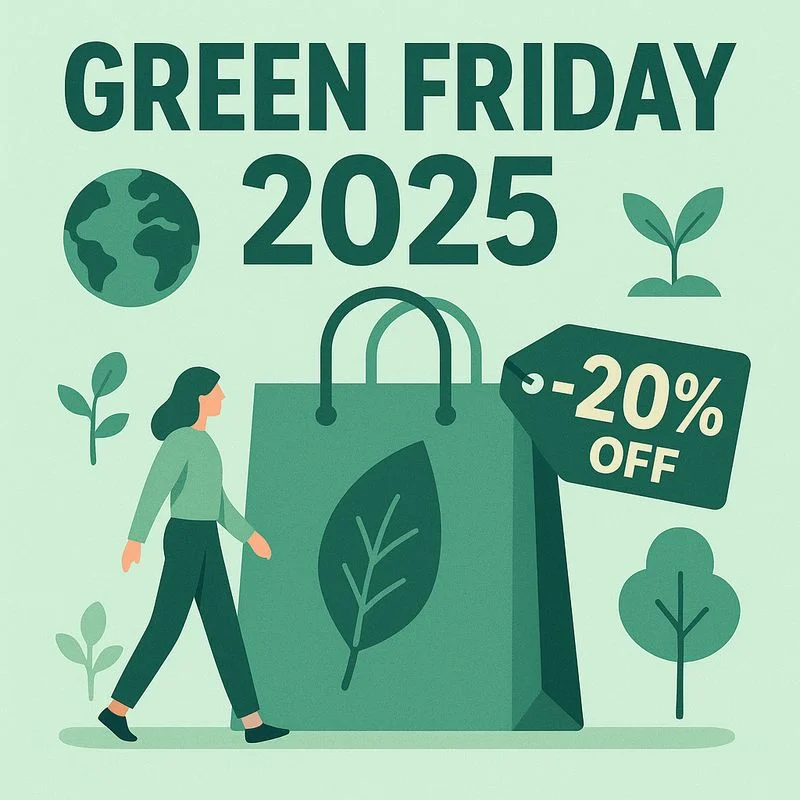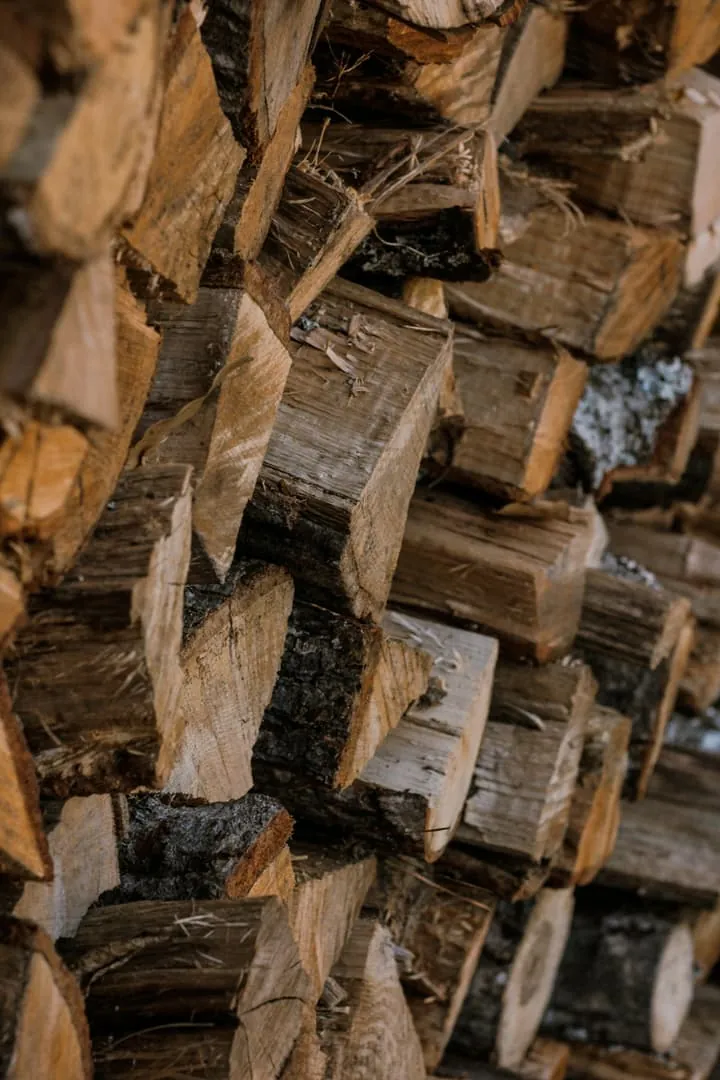
Green Friday 2025: The Sustainable Alternative That’s Finally Overtaking Black Friday
While Black Friday triggers more than €20 billion in European spending each year, 2025 marks a powerful shift: the rise of Green Friday. Born as a reaction to overconsumption and the environmental cost of fast retail, the movement is finally capturing mainstream attention. More than 300 major European brands have announced that they will refuse aggressive discounts, instead promoting repair, second-hand products and ethical shopping.
1. Why Green Friday is booming in 2025
Fast-fashion scandals, overflowing warehouses and rising climate anxiety have changed how Europeans look at November sales. Across France, Belgium and the Nordics, more than 64 % of consumers say they want to reduce their climate impact and move away from impulse shopping.
Instead of buying piles of low-quality products that end up in a drawer or the bin, more people are choosing purchases that are useful, durable and repairable.
Three main drivers explain the 2025 boom:
- New anti-waste laws in Europe: several countries now restrict the destruction of unsold goods and push retailers to be more transparent.
- The right to repair, strengthened at EU level, makes it easier to fix devices instead of replacing them.
- The rise of minimalism and local shopping, especially in committed cities like Amsterdam, Lyon or Barcelona.
If you are interested in changing your rhythm year-round, our guide on slow living and deeper relationships explores how consuming less can also improve your wellbeing.
2. Black Friday vs Green Friday: two opposite mindsets
| Criterion | Black Friday | Green Friday |
|---|---|---|
| Goal | Maximise sales volume | Favour durability and restraint |
| Products | New, often very cheap | Durable, repairable, often local |
| Impact | More waste and CO₂ | Reduced footprint |
| Values | Impulse and accumulation | Reflection and quality |
3. How to join Green Friday 2025 (without feeling deprived)
Green Friday is not about never buying anything again. It is about choosing what really matters and avoiding marketing pressure. Here are six simple ways to take part:
- Buy less, but better Pick one high-quality item instead of several fast-fashion or disposable purchases. Think long-term cost per use, not just the sticker price.
- Prefer second-hand Look for refurbished or pre-loved products on platforms such as Vinted, Back Market, Vestiaire Collective or Leboncoin. You extend product life while avoiding new production. Our guide on sustainable fashion 2025 explains how to spot quality pieces that last.
- Support local makers Christmas markets and craft fairs starting in November are perfect to back small businesses and artisans. Handmade candles, ceramics or textiles often have a much lower footprint than imported mass-market gifts. For more ideas, explore our article on autumn markets and local producers.
- Offer experiences instead of objects Workshops, cultural passes, cooking classes, bike repairs or a train trip emit far less CO₂ than many physical gifts — and create memories rather than clutter. You can combine this with greener travel habits from our guide on making your journeys more sustainable.
- Repair instead of replacing From smartphones to winter coats, 2025 is the year of the repair mindset. Look for local repair cafés, cobblers or seamstresses, and tech repair shops that work with refurbished parts.
- Choose locally processed products Think local honey, artisanal cosmetics, loose organic groceries or upcycled textiles. Food and wellness gifts are ideal low-waste options. Our piece on seasonal organic baskets in Europe shows how local food networks can replace impulse supermarket buys.
4. 20 sustainable Green Friday gift ideas for 2025
Here is a practical checklist for eco-conscious gift ideas this year.
For the home
- Zero-waste starter kits (beeswax wraps, bamboo brushes).
- Air-purifying plants instead of synthetic air fresheners.
- Non-paraffin candles with natural wax and cotton wicks.
- Linen or hemp textiles made in Europe.
For wellbeing
- Locally made solid cosmetics.
- DIY aromatherapy or herbal kit with clear instructions.
- Gift cards for local spas, yoga studios or massage therapists.
For food lovers
- Organic, regional food hampers with seasonal products.
- Fairtrade chocolate and coffee.
- Plant-based cooking classes or fermentation workshops. For more inspiration, try our guides on zero-waste autumn cooking and seasonal soups.
For tech fans
- Premium refurbished smartphones or laptops.
- Repairable wired or modular headphones.
- Portable solar chargers or power banks.
For fashion lovers
- T-shirts or knitwear made from recycled fibres.
- Upcycled sneakers from responsible brands.
- Handmade accessories from local designers. Our article on sustainable fashion 2025 gives criteria to avoid greenwashing.
Each of these ideas supports the circular economy while still feeling generous and festive.
5. Ethical brands backing Green Friday 2025
In 2025, more than 400 companies officially communicate around Green Friday. Among the best-known names are:
- Patagonia, which has a long tradition of closing campaigns that question overconsumption.
- Asphalte, which refuses flash sales and focuses on transparent pricing and pre-orders.
- Veja, a sneaker brand built on organic cotton, wild rubber and traceable supply chains.
- Lush, which runs strong anti-waste messages and solid cosmetics with minimal packaging.
- Back Market, a leading refurbished tech marketplace.
- Dream Act, a curated platform gathering ethical brands and services.
In 2025, many of these companies donate up to 10 % of their sales from the period to environmental or social organisations instead of pushing extreme discounts.
6. The rise of the repair mindset
Thanks to the strengthened European Right to Repair, manufacturers are increasingly obliged to provide spare parts and repair documentation for several years after purchase. That makes it easier — and cheaper — to fix devices rather than bin them.
The effects are already visible:
- Smartphone repairs are up by more than 30 % in some EU countries.
- Community repair workshops and repair cafés are opening in many cities.
- Brands that design for durability and repairability are gaining market share.
Repairing instead of replacing can cut the carbon footprint of a product by 60 to 80 % over its lifecycle. Combined with energy-saving habits from our guide on staying warm while wasting less energy, it becomes a powerful climate action.
7. Avoiding overconsumption, even when it looks green
The main risk with Green Friday is using sustainability as an excuse to buy just as much as before. A gift made from organic cotton or recycled plastic is still a product that needed resources.
To stay aligned with your values, use these golden rules:
- Ask yourself: “Will I still use this in six months?”
- Write a list 48 hours before buying anything and stick to it.
- Set a maximum budget for November sales and track it.
- Prioritise artisans and small businesses over big brands doing minimal “green” campaigns.
For more support with simplifying your lifestyle, see our article on reducing stress with green routines.
8. Data that shows Green Friday is catching up with Black Friday
According to a 2025 report from a European consumer observatory:
- Google searches for “Green Friday” are up more than 37 % year-on-year.
- 42 % of 18–35 year olds say they intend to avoid Black Friday altogether.
- In several categories (smartphones, premium fashion), second-hand sales now rival or exceed new sales.
- Ethical brands report average sales growth of +18 % without using extreme discounts.
Green Friday will not erase Black Friday overnight, but it is clearly moving from niche campaign to mainstream behaviour.
9. Where to find Green Friday initiatives near you
To move from intention to action, look for:
- Local repair cafés and community workshops.
- Zero-waste bulk shops and independent eco-stores.
- Online ethical platforms like Dream Act, WeDressFair or Rutabago for responsible products and meal kits.
- Municipal repair or upcycling workshops.
- Artisan and makers’ markets in November and December.
Combining these local options with your own rules (budget, lists, second-hand first) will make Green Friday concrete and enjoyable.
Frequently Asked Questions
Is Green Friday replacing Black Friday?
Not completely, but its visibility and influence are growing strongly in 2025.
What are the best sustainable gifts to buy in 2025?
Look for repairable, durable, local, natural or refurbished gifts rather than one-off gadgets.
Is Green Friday really eco-friendly?
Yes — if it goes hand in hand with buying less overall, avoiding unnecessary deliveries and choosing long-lasting items.
How can I reduce my carbon footprint during Black Friday?
Favour second-hand, avoid express delivery where possible, group orders, and support local artisans or experiences instead of high-impact products.
Conclusion: Green Friday 2025 is not a passing trend — it is a cultural shift driven by environmental urgency. By choosing responsible purchases, favouring second-hand, supporting artisans and embracing mindful consumption, people regain control over their impact and send a clear signal to the market. This year, real power does not lie in aggressive sales — it lies in the choice to say no to overconsumption.
About the author:
Alexandre Dubois is a French sustainability enthusiast sharing practical tips for greener living. With years of experience in energy efficiency consulting, he helps households reduce their environmental impact without sacrificing comfort. Contact: info@greendailyfix.com
Related posts

Zero-Waste Winter Cooking: Turning Leftovers into Comfort Meals
As winter sets in, our meals get heartier — and our fridges fuller. Unfortunately, that often means more food waste. But zero-waste cooking isn't about restriction; it's about creativity and comfort. Here's how to turn leftovers into cozy, money-saving winter meals.

Stay Warm Without Breaking the Bank: Heating & Budget Tips for Winter 2025
Energy prices are rising again, and winter is coming. The good news: simple actions can keep your home warm without blowing your budget. From thermostat tweaks to daily habits, here's your practical guide to a cozy, cost-efficient winter.

Night of Lanterns: Bringing Meaning Back to Halloween
Beneath the layers of plastic and candy, Halloween hides an ancient, poetic story — that of **Samhain**, the Celtic festival marking the end of light and the start of the dark season. This October 31, instead of consuming, what if we returned to celebrating — by lantern light, in respect for nature and remembrance?

Recycled Halloween Costumes: Creative Ideas for All Ages
Each year, millions of Halloween costumes are worn once and thrown away. Made of polyester and plastic, they leave a scary carbon footprint. Yet building your own costume from recycled clothes and materials is easy, fun, and far more sustainable. Here's how to make eco-creative costumes for kids and adults alike.